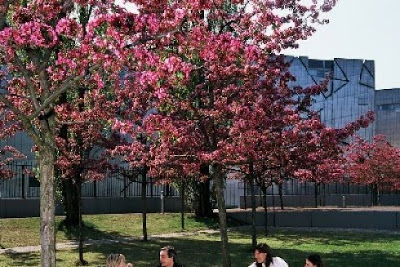
Nikita Kruktunov and Rufina Muharanova, Omsk, May 2005. Picture: Simon Roberts/Courtesy Art Collection Deutsche Börse
"Visions of our Time" at C/O Berlin celebrates ten years of the Art Collection Deutsche Börse and features the work of the 4 nominees for the 2009 Deutsche Börse Photography Prize.
The prizewinning and shortlisted photographs take pride of place in the exhibition, but the more interesting section, at least in terms of technique and composition, may be the other half of the show: a group of 100 of the more than 700 works in the Deutsche Börse's collection of contemporary photography.
Filmic Haikus
Paul Graham is winner of the £30,000 award for his series named a shimmer of possibility after a collection of Chekov's short stories. Graham made an extended road trip across the US between 2004-06, taking pictures of everyday life. What interested him was not the one defining moment but sequences that capture simple human activities -- somebody lighting a cigarette, cutting grass or waiting for a bus.
Graham's photographs are sequential shots of these single activities, and Graham likes to call them "haikus" rather than narratives. Not much is happening in Graham's shots. They are often ad hoc pictures, sometimes badly lit, as in the sequence of the (homeless?) person selling a bunch of flowers, and mostly about no more than "being there."
Archivist, Detective, Activist
Kuwaiti artist Emily Jacir is one of the three other nominees for the prize, and her featured work is "Material for a Film," a multimedia installation documenting the assassination of the Palestinian intellectual Wael Zuwaiter by Israeli agents in Rome in 1972.
Jacir arranges photographs, texts and objects to piece together the story, and some stop you in your tracks -- such as the copy of the 1001 Arabian Nights Zuwaiter was carrying in his pocket when he was shot. Lodged in the cover is a bullet, the only one which did not pierce Zuwaiter's chest.
Still, you can't help wondering what Jacir's work is doing in a photo exhibition. She is much more of an archivist than a photographer.
White Tiger
The White Tiger is the most well known of Taryn Simon's picture-and-text series entitled "American Index of the Hidden and Unfamiliar." Simon, another nominee for the prize, concentrates on images of contemporary America that tap into the hidden or darker sides of the culture, a kind of nationwide Discomfort Zone.
The white tiger (Kenny) at the Arkansas zoo is a product of selective inbreeding, and he is physically and mentally malformed. Like Kenny, all of Simon's subjects are fascinating: the contraband room of the customs section of JFK Airport; a Braille edition of Playboy; a female patient undergoing hymenoplasty, a surgical procedure which masks the loss of virginity; and a bird's eye view of drums of nuclear waste under water. In the end, though, Simon's subjects may be more memorable than her use of the medium.
Adam and Eve in Central Park
Tod Papageorge is my favorite of the four shortlisted artists. His black-and-white series shot over twenty five years in Central Park is called "Passing Through Eden" and is based on the first six chapters of Genesis.
Through Papageorge's lens, Central Park is transformed into a prelapsarian world. It's a familiar world (still recognizably New York of the 60s and 70s) but also strangely magical. As you walk by the pictures in the first half of the series it is not difficult to decode a sequence of Biblical references. The narrative then continues to unfold in the second half, and Papageorge's photographs seem able to encompass all of human life within the boundaries of the Park: its innocence, beauty, ugliness and mystery, but also its humor.

Picture: Tod Papageorge/Courtesy Pace/MacGill Gallery, New York
I returned a couple of times to one particular photo -- in perfect symmetrical proportions -- of three men on a park bench. The first is straddled by his girlfriend in an amorous embrace, the second is lost in his newspaper, the third is trying to decipher something on a slip of paper -- a shopping list? an incomprehensible bill?
On the upper floor are the 100 photographs from the rest of the collection, among which are some unforgettable images. I'll mention just three. First, the striking portraits of Seydou Keita, the photographer from Bamako, Mali, who never went to college, never saw the works of photographers outside his country, and never had a teacher. His clients, the simple people of his hometown in the 1950s, lined up outside his studio because Keita's portraits made them beautiful, and he gave each a touch of West African tradition.

Then, the portrait series called "Heads" by Philip-Lorca di Corcia, who marked a spot on the ground at Times Square, New York, mounted a camera and telephoto lens a long distance away, then released the shutter every time someone he found interesting walked over the spot. From the swirling life around the Square, the camera seizes his subjects while the background melts away, and the viewer sees a cross-section of New Yorkers as individuals in a moment of unawareness.
And finally, the selection of photos from British photographer Simon Robert's series called "Motherland," the result of his yearlong exploration of Russia, documenting the lives of local people through a vast sweep of the country. The proud gaze of the two young competition dancers from Siberia, the girl in a peacock blue dress, is one of the images that stayed with me.
"Visions of our Time" is at C/O Berlin, Oranienburger Straße 35/36, 10117 Berlin (S Oranienburger Straße) and runs till 19. July, 2009. Open everyday from 11 am to 8 pm. Tickets cost 7 Euro (reduced: 5 Euro). See www.co-berlin.com for more details.










































